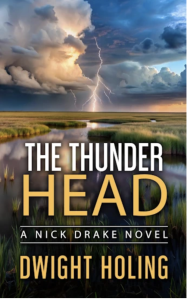Hear the conversation | Get the book

By the time Dwight Holing takes us into the sun-scorched reaches of Harney County, Oregon—a setting as desolate as it is defiant—one senses that he’s not merely writing about the land, but listening to it. His latest novel, The Thunder Head, the newest installment in the Nick Drake mystery series, unfolds not simply as a whodunit, but as a meditation on wilderness, memory, and moral collision. Holing’s protagonist, a Vietnam veteran and wildlife ranger with battle scars both visible and not, serves as the author’s emissary to a landscape steeped in quiet menace and vast, aching beauty.
That Holing arrived at fiction through the byways of journalism is perhaps no surprise. Before Nick Drake was even a sketch in his notebook, Holing had written for Time, Life, and Smithsonian, reporting on everything from the trafficking of orangutans in Sumatra to conservation fights on remote continents. His writing bears the signature of that experience—stories rooted in people and place, shaped by conflict, sharpened by consequence.
If the terrain of Harney County seems vividly drawn, that’s because it is. Holing’s connection to Oregon began decades ago, during his time at the University of Oregon in Eugene, and deepened through summer work in Alaska and later, through marriage to a self-described “kickass environmentalist.” When Holing writes about standing atop Steens Mountain and gazing out across the purple sagebrush to the Alvord Desert, you believe him. He’s not conjuring a scene; he’s revisiting one. “If you’re there at night,” he says, “you see more stardust than anywhere.”
Nick Drake, the fictional center of this orbit, is a creature of consequence. A former LURP—Long Range Reconnaissance Patrol sergeant—he emerges from the wreckage of 1969, the lone survivor of an ambushed squad. Heroin addiction, time in Walter Reed, and a diagnosis of “combat fatigue”—the precursor to PTSD—follow. But salvation arrives in an unlikely form: a real-life program that employed veterans as federal wildlife rangers. For Drake, the wild becomes sanctuary, penance, and battleground.
In The Thunder Head, Drake is drawn into a procedural investigation—Holing’s nod to a genre he respects—alongside his father-in-law, Sheriff Pudge Warbler, who is now battling cancer. Their investigation circles around a violent land dispute, where ranchers and developers clash over visions of what the West should be: preserved heritage or profited future. As Holing puts it, “It’s pitting ranchers against developers who want to turn it into the next Sun River.” The stakes are not merely ecological or economic; they are familial, existential.
Holing’s reverence for storytelling runs in the blood. His grandfather, whose names he bears as middle initials, once worked alongside Chandler and Wilder, writing for Collier’s and the Saturday Evening Post. Though he never met the man, Holing inherited the lore: Chandler asleep on the couch in white gloves, poker chips and gin in the air. Such stories shape a writer. Holing’s first attempt—an elementary school essay titled “Bloody Murder”—earned him an F but also forecast a future.
Still, the road to novels was not direct. He began with short stories, literary in tone, then veered into noir with a tale about a con artist. That piece, published in Spine Tingler Magazine, caught the eye of an editor who declared it a series. The Jack McCool books followed, set in the chaotic glow of San Francisco. But it was Oregon, with its vast silences and moral wilds, that called Holing back. And it was Nick Drake who answered.
Drake’s world is not only richly imagined but respectfully inclusive. In The Thunder Head, Holing introduces a Tlingit character from Alaska, a woman seeking justice in the wake of violence. Her presence sharpens the narrative’s edge, prompting all involved to reckon with the blurry border between retribution and righteousness. Holing approached the storyline cautiously, consulting friends from the Cherokee Nation. “If you do it with a lot of good research, talk to a lot of people, you’re honest, respectful,” he was told, “we need people to get our stories out.” That imperative—to portray rather than appropriate—guides him.
The writing process itself has evolved. Where once he plotted with precision, Holing now listens. “My characters are telling the story,” he says. “All I need to do is listen.” His shift from planner to “pantser” reflects not a lack of structure but a surrender to narrative instinct, a trust in character over choreography. It’s an evolution well-suited to the unpredictable rhythms of both nature and mystery.
And his readers? They are ravenous. “I just released this book,” he laughs, “and already I’m getting emails: ‘Okay, where’s number ten?’” The cinematic quality of his prose—each scene imagined “shot by shot”—lends itself to screen adaptation, and one senses that such a future is not far off. But for now, Holing remains focused on the written word, on the page as landscape, as compass.
What comes next for Nick Drake remains, by Holing’s design, uncertain. But the themes—justice, change, the wildness of both land and soul—are far from finished. Harney County has more stories, and Holing is ready to tell them. In the meantime, readers follow Drake’s dusty trail, guided by a voice that is both weathered and wide open, much like the land it inhabits.

